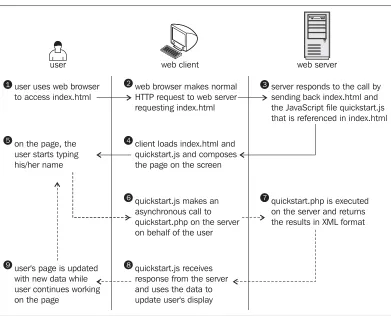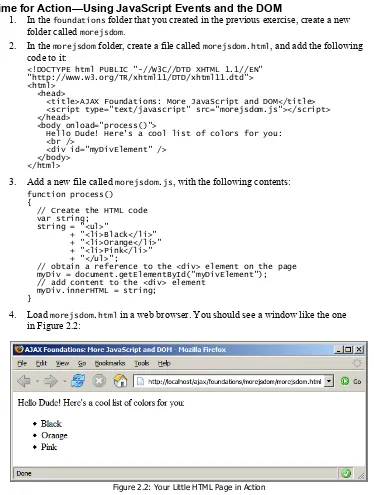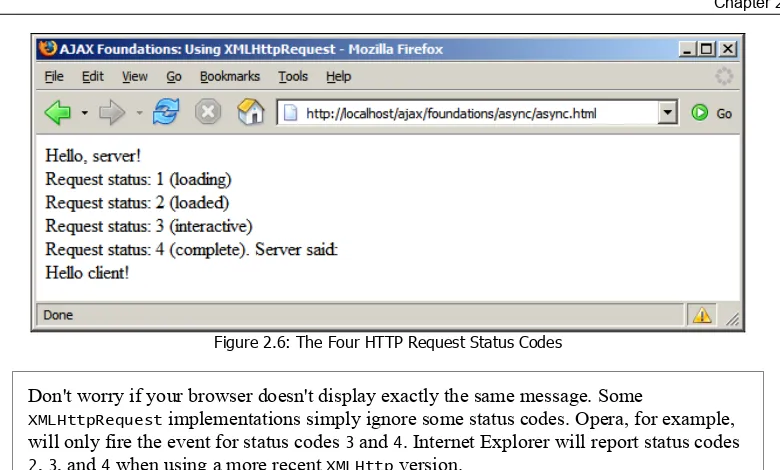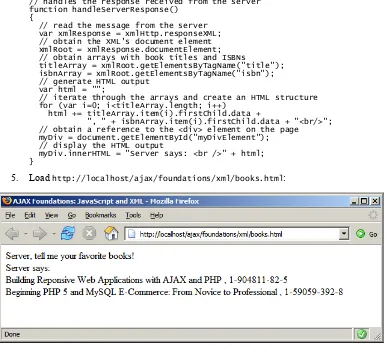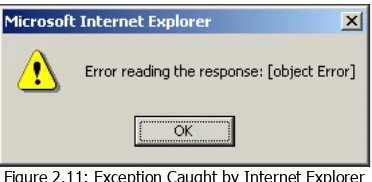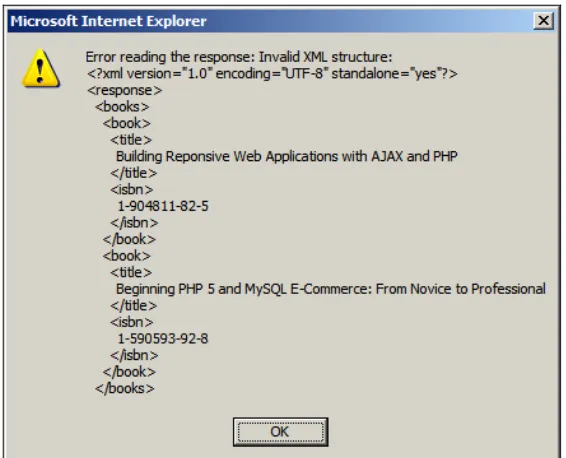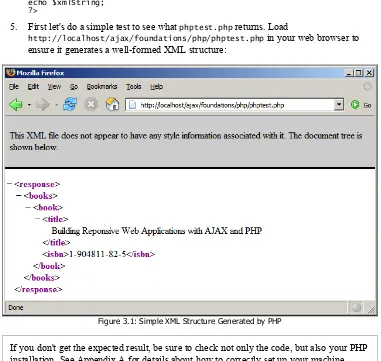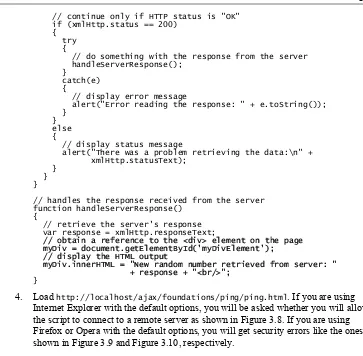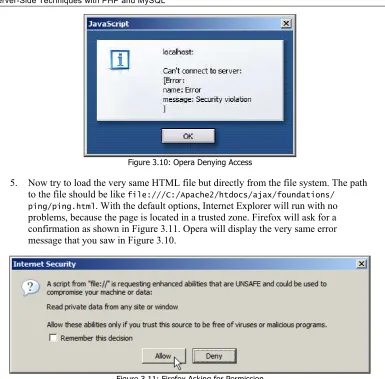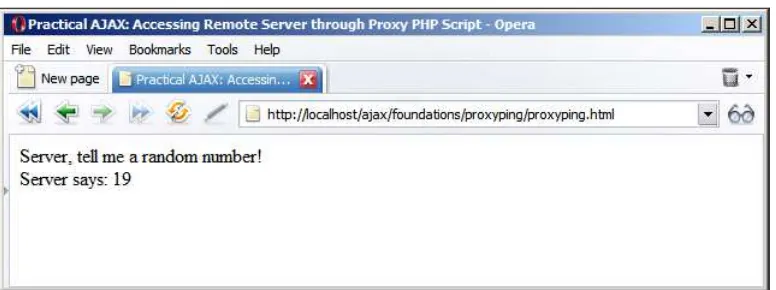AJAX and PHP
Building Responsive Web Applications
Enhance the user experience of your PHP website
using AJAX with this practical tutorial featuring detailed
case studies
AJAX and PHP
Building Responsive Web Applications
Copyright © 2006 Packt Publishing
All rights reserved. No part of this book may be reproduced, stored in a retrieval system, or
transmitted in any form or by any means, without the prior written permission of the publisher,
except in the case of brief quotations embedded in critical articles or reviews.
Every effort has been made in the preparation of this book to ensure the accuracy of the
information presented. However, the information contained in this book is sold without warranty,
either express or implied. Neither the authors, Packt Publishing, nor its dealers or distributors will
be held liable for any damages caused or alleged to be caused directly or indirectly by this book.
Packt Publishing has endeavored to provide trademark information about all the companies and
products mentioned in this book by the appropriate use of capitals. However, Packt Publishing
cannot guarantee the accuracy of this information.
First published: March 2006
Production Reference: 1210206
Published by Packt Publishing Ltd.
32 Lincoln Road
Olton
Birmingham, B27 6PA, UK.
ISBN 1-904811-82-5
www.packtpub.com
Credits
Authors
Cristian Darie
Brinzarea Bogdan
Filip Chereche
ş
-To
ş
a
Mihai Bucica
Reviewers
Emilian Balanescu
Paula Badascu
Technical Editor
Jimmy Karumalil
Editorial Manager
Dipali Chittar
Development Editor
Cristian Darie
Indexer
Ashutosh Pande
Proofreader
Chris Smith
Production Coordinator
Manjiri Nadkarni
About the Authors
Cristian Darie
is a software engineer with experience in a wide range of modern technologies,
and the author of numerous technical books, including the popular "Beginning E-Commerce"
series. Having worked with computers since he was old enough to press the keyboard, he initially
tasted programming success with a first prize in his first programming contest at the age of 12.
From there, Cristian moved on to many other similar achievements, and now he is studying
distributed application architectures for his PhD degree. He always loves hearing feedback about
his books, so don't hesitate dropping a "hello" message when you have a spare moment. Cristian
can be contacted through his personal website at
www.cristiandarie.ro
.
Cristian would like to express a big "thank you!" to his co-authors, Bogdan, Filip, and Mihai
and to the Technical Editor of the book, Jimmy, for the hard work they've put into building
this wonderful book.
Bogdan Brinzarea
has a strong background in Computer Science holding a Master and
Bachelor Degree at the Automatic Control and Computers Faculty of the Politehnica University of
Bucharest, Romania and also an Auditor diploma at the Computer Science department at Ecole
Polytechnique, Paris, France.
Filip Chereche
ş
-To
ş
a
is a web developer with a firm belief in the future of web-based software.
He started his career at the age of 9, when he first got a Commodore 64 with tape-drive.
Back home in Romania, Filip runs a web development company named eXigo
www.exigo.ro
,
which is actively involved in web-based application development and web design. He is currently
a student at the University of Oradea, studying Computer Science, and also an active member of
the Romanian PHP Community
www.phpromania.net
.
Mihai Bucica
started programming and competing in programming contests (winning many
of them), all at age twelve. With a bachelor's degree in computer science from the Automatic
Control and Computers Faculty of the Politehnica University of Bucharest, Romania, Bucica
works on building communication software with various electronic markets.
Even after working with a multitude of languages and technologies, Bucica's programming
language of choice remains C++, and he loves the LGPL word. Mihai also co-authored
Beginning
PHP 5 and MySQL E-Commerce
and he can be contacted through his personal website,
About the Reviewers
Emilian Balanescu
is a programmer experienced in many technologies, including PHP, Java,
.NET, PostgreSQL, MS SQL Server, MySQL, and others. He currently works as a Wireless
Network Administrator at accessNET International S.A. Romania, a company that provides fixed
wireless access services operating a point-to-multipoint digital radio communication network with
national coverage. His latest project in this position was developing an AJAX-enabled real-time
Network Management System (using SNMP, Perl, PHP, and PostgreSQL) used for remote
debugging, monitoring system performance, and isolating and troubleshooting system problems.
You can reach Emilian at
http://www.emilianbalanescu.ro
.
Table of Contents
Preface 1
Chapter 1: AJAX and the Future of Web Applications
7
Delivering Functionality via the Web
8
Advantages of Web Applications
9
Building Websites Since 1990
10
HTTP and HTML
10
PHP and Other Server-Side Technologies
11
JavaScript and Other Client-Side Technologies
12
What's Been Missing?
13
Understanding AJAX
14
Building a Simple Application with AJAX and PHP
18
Time for Action—Quickstart AJAX
21
Summary 28
Chapter 2: Client-Side Techniques with Smarter JavaScript
29
JavaScript and the Document Object Model
30
Time for Action—Playing with JavaScript and the DOM
32
JavaScript Events and the DOM
33
Time for Action—Using JavaScript Events and the DOM
35
Even More DOM
37
Time for Action—Even More DOM
37
JavaScript, DOM, and CSS
39
Time for Action—Working with CSS and JavaScript
39
Using the XMLHttpRequest Object
42
Creating the XMLHttpRequest Object
43
Creating Better Objects for Internet Explorer
45
Initiating Server Requests Using XMLHttpRequest
46
Handling Server Response
49
Working with XML Structures
55
Time for Action—Making Asynchronous Calls with XMLHttpRequest and XML 55
Handling More Errors and Throwing Exceptions
59
Creating XML Structures
63
Summary 64
Chapter 3: Server-Side Techniques with PHP and MySQL
65
PHP and DOM
65
Time for Action—Doing AJAX with PHP
66
Passing Parameters and Handling PHP Errors
71
Time for Action—Passing PHP Parameters and Error Handling
72
Connecting to Remote Servers and JavaScript Security
79
Time for Action—Connecting to Remote Servers
81
Using a Proxy Server Script
85
Time for Action—Using a Proxy Server Script to Access Remote Servers
86
A Framework for Making Repetitive Asynchronous Requests
91
Time for Action—Implementing Repetitive Tasks
93
Working with MySQL
101
Creating Database Tables
101
Manipulating Data
104
Connecting to Your Database and Executing Queries
105
Time for Action—Working with PHP and MySQL
106
Wrapping Things Up and Laying Out the Structure
109
Time for Action—Building the Friendly Application
112
Summary 119
Chapter 4: AJAX Form Validation
121
Implementing AJAX Form Validation
122
Thread-Safe AJAX
125
Time for Action—AJAX Form Validation
126
Summary 144
Chapter 5: AJAX Chat
145
Introducing AJAX Chat
145
Table of Contents
Chapter 6: AJAX Suggest and Autocomplete
165
Introducing AJAX Suggest and Autocomplete
165
Google Suggest
166
Implementing AJAX Suggest and Autocomplete
167
Time for Action—AJAX Suggest and Autocomplete
168
Summary 188
Chapter 7: AJAX Real-Time Charting with SVG
189
Implementing a Real-Time Chart with AJAX and SVG
190
Time for Action—Building the Real-Time SVG Chart
193
Summary 202
Chapter 8: AJAX Grid
203
Implementing the AJAX Grid Using Client-Side XSLT
204
Time for Action—AJAX Grid
205
Summary 221
Chapter 9: AJAX RSS Reader
223
Working with RSS
223
The RSS Document Structure
224
Google Reader
224
Implementing the AJAX RSS Reader
225
Time for Action—Building the RSS Reader Application
226
Summary 236
Chapter 10: AJAX Drag and Drop
237
Using Drag and Drop on the Web
237
Shopping Carts
237
Sortable Lists
238
Building the AJAX Drag-and-Drop Sortable List Application
238
Time for Action—Task Management Application with AJAX
241
Summary 253
Appendix A: Preparing Your Working Environment
255
Preparing Your Windows Playground
256
Installing Apache
256
Installing MySQL
258
Preparing Your *nix Playground
261
Installing Apache
261
Installing MySQL
261
Installing PHP
262
Installing phpMyAdmin
263
Preparing the AJAX Database
264
Preface
AJAX is a complex phenomenon that means different things to different people. Computer users
appreciate that their favorite websites are now friendlier and feel more responsive. Web
developers learn new skills that empower them to create sleek web applications with little effort.
Indeed, everything sounds good about AJAX!
At its roots, AJAX is a mix of technologies that lets you get rid of the evil page reload, which
represents the dead time when navigating from one page to another. Eliminating page reloads is
just one step away from enabling more complex features into websites, such as real-time data
validation, drag and drop, and other tasks that weren't traditionally associated with web
applications. Although the AJAX ingredients are mature (the
XMLHttpRequest
object, which is
the heart of AJAX, was created by Microsoft in 1999), their new role in the new wave of web
trends is very young, and we'll witness a number of changes before these technologies will be
properly used to the best benefit of the end users. At the time of writing this book, the "AJAX"
name is about just one year old.
AJAX isn't, of course, the answer to all the Web's problems, as the current hype around it may
suggest. As with any other technology, AJAX can be overused, or used the wrong way. AJAX
also comes with problems of its own: you need to fight with browser inconsistencies,
AJAX-specific pages don't work on browsers without JavaScript, they can't be easily
bookmarked by users, and search engines don't always know how to parse them. Also, not
everyone likes AJAX. While some are developing enterprise architectures using JavaScript,
others prefer not to use it at all. When the hype is over, most will probably agree that the middle
way is the wisest way to go for most scenarios.
In
AJAX and PHP: Building Responsive Web Applications
, we took a pragmatic and safe approach
by teaching relevant patterns and best practices that we think any web developer will need sooner
or later. We teach you how to avoid the common pitfalls, how to write efficient AJAX code, and
how to achieve functionality that is easy to integrate into current and future web applications,
without requiring you to rebuild the whole solution around AJAX. You'll be able to use the
knowledge you learn from this book right away, into your PHP web applications.
What This Book Covers
Chapter 1
:
AJAX and the Future of Web Applications
is an initial incursion into the world of
AJAX and the vast possibilities it opens up for web developers and companies, to offer a better
experience to their users. In this chapter you'll also build your first AJAX-enabled web page,
which will give you a first look of the component technologies.
Chapter 2
:
Client-Side Techniques with Smarter JavaScript
will guide you through the
technologies you'll use to build AJAX web clients, using JavaScript, the DOM, the
XMLHttpRequest
object, and XML. While not being a complete tutorial for these technologies, you'll be put on the
right track for using them together to build a solid foundation for your future applications.
Chapter 3
:
Server-Side Techniques with PHP and MySQL
completes the theoretical foundation by
presenting how to create smart servers to interact with your AJAX client. You'll learn various
techniques for implementing common tasks, including handling basic JavaScript security and
error-handling problems.
Chapter 4
:
AJAX Form Validation
guides you through creating a modern, responsive, and secure
form validation system that implements both real-time AJAX validation and server-side validation
on form submission.
Chapter 5
:
AJAX Chat
presents a simple online chat that works exclusively using AJAX code, without
using Java applets, Flash code, or other specialized libraries as most chat applications do these days.
Chapter 6
:
AJAX Suggest and Autocomplete
builds a Google Suggest-like feature, that helps you
quickly find PHP functions, and forwards you to the official help page for the chosen function.
Chapter 7
:
AJAX Real-Time Charting with SVG
teaches you
how to implement a real-time
charting solution with AJAX and SVG. SVG (Scalable Vector Graphics) is a text-based graphics
language that can be used to draw shapes and text.
Chapter 8
:
AJAX Grid
teaches you how to build powerful AJAX-enabled data grids. You'll learn
how to parse XML documents using XSLT to generate the output of your grid.
Chapter 9
:
AJAX RSS Reader
uses the SimpleXML PHP library, XML, and XSLT to build a
simple RSS aggregator.
Chapter 10
:
AJAX Drag and Drop
is a demonstration of using the script.aculo.us framework to
build a simple list of elements with drag-and-drop functionality.
Appendix A
:
Preparing Your Working Environment
teaches you how to install and configure the
required software: Apache, PHP, MySQL, phpMyAdmin. The examples in this book assume that
you have set up your environment and sample database as shown here.
Preface
What You Need for This Book
To go through the examples of this book you need PHP 5, a web server, and a database server. We
have tested the code under several environments, but mostly with the Apache 2 web server, and
MySQL 4.1 and MySQL 5 databases.
You can choose, however, to use another web server, or another database product, in which case
the procedures presented in the chapters might not be 100% accurate. It is important to have PHP
5 or newer, because we use some features, such as Object Oriented Programming support, which
aren't available in older versions.
Please read Appendix A for more details about setting up your machine. If your machine already
has the required software, you still need to read the final part of Appendix A, where you are
instructed about creating a database that is used for the examples in this book.
Conventions
In this book, you will find a number of styles of text that distinguish between different kinds of
information. Here are some examples of these styles, and an explanation of their meaning.
There are three styles for code. Code words in text are shown as follows: "We can include other
contexts through the use of the
include
directive."
A block of code will be set as follows:
// function calls the server using the XMLHttpRequest object
function process()
{
// retrieve the name typed by the user on the form
name = document.getElementById("myName").value;
// execute the quickstart.php page from the server
xmlHttp.open("GET", "quickstart.php?name=" + name, false);
// make synchronous server request
xmlHttp.send(null);
// read the response
handleServerResponse();
}
When we wish to draw your attention to a particular part of a code block, the relevant lines or
items will be made bold:
// function calls the server using the XMLHttpRequest object
function process()
{
// retrieve the name typed by the user on the form
name = document.getElementById("myName").value;
// execute the quickstart.php page from the server
xmlHttp.open("GET", "quickstart.php?name=" + name, false);
// make synchronous server request
Any command-line input and output is written as follows:
./configure --prefix=/usr/local/apache2 --enable-so --enable-ssl
--with-ssl --enable-auth-digest
New terms
and
important words
are introduced in a bold-type font. Words that you see on the
screen, in menus or dialog boxes for example, appear in our text like this: "clicking the
Next
button moves you to the next screen".
Warnings or important notes appear in a box like this.
Tips and tricks appear like this.
Reader Feedback
Feedback from our readers is always welcome. Let us know what you think about this book, what
you liked or may have disliked. Reader feedback is important for us to develop titles that you
really get the most out of.
To send us general feedback, simply drop an email to
[email protected]
, making sure to
mention the book title in the subject of your message.
If there is a book that you need and would like to see us publish, please send us a note in the
form on
SUGGEST A TITLE
www.packtpub.com
or email
[email protected]
.
If there is a topic that you have expertise in and you are interested in either writing or contributing
to a book, see our author guide on
www.packtpub.com/authors
.
Customer Support
Now that you are the proud owner of a Packt book, we have a number of things to help you to get
the most from your purchase.
Downloading the Example Code for the Book
Visit
http://www.packtpub.com/support
, and select this book from the list of titles to
download any example code or extra resources for this book. The files available for download will
then be displayed.
Preface
Errata
Although we have taken every care to ensure the accuracy of our contents, mistakes do happen. If
you find a mistake in one of our books—maybe a mistake in text or code—we would be grateful if
you would report this to us. By doing this you can save other readers from frustration, and help to
improve subsequent versions of this book. If you find any errata, report them by visiting
http://www.packtpub.com/support
, selecting your book, clicking on the
Submit Errata
link, and entering the details of your errata. Once your errata have been verified, your submission
will be accepted and the errata added to the list of existing errata. The existing errata can be
viewed by selecting your title from
http://www.packtpub.com/support
.
Questions
1
AJAX and the Future of
Web Applications
"Computer, draw a robot!" said my young cousin to the first computer he had ever seen. (Since I
had instructed it not to listen to strangers, the computer wasn't receptive to this command.) If
you're like me, your first thought would be "how silly" or "how funny"—but this is a mistake. Our
educated and modeled brains have learned how to work with computers to a certain degree. People
are being educated to accommodate computers, to compensate for the lack of ability of computers
to understand humans. (On the other hand, humans can't accommodate very well themselves, but
that's another story.)
This little story is relevant to the way people instinctively work with computers. In an ideal world,
that spoken command should have been enough to have the computer please my cousin. The
ability of technology to be user-friendly has evolved very much in the past years, but there's still a
long way till we have real intelligent computers. Until then, people need to learn how to work with
computers—some to the extent that they end up loving a black screen with a tiny command
prompt on it.
Not incidentally, the computer-working habits of many are driven by software with user interfaces
that allow for intuitive (and enjoyable) human interaction. This probably explains the popularity of
the right mouse button, the wonder of fancy features such as drag and drop, or that simple text box
that searches content all over the Internet for you in just 0.1 seconds (or so it says). The software
industry (or the profitable part of it, anyway) has seen, analyzed, and learned. Now the market is
full of programs with shiny buttons, icons, windows, and wizards, and people are
paying a lot of
money for them
.
What the software industry has learned is that the equivalent of a powerful engine in a red sports
car is
usability and accessibility
for software. And it's wonderful when what is good from the
business point of view is also good from a human point of view, because the business profits are
more or less proportional to customers' satisfaction.
Understanding the way people's brains work would be the key to building the ultimate software
applications. While we're far from that point, what we do understand is that end users need
intuitive user interfaces; they don't really care what operating system they're running as long as the
functionality they get is what they
expect
. This is a very important detail to keep in mind, as many
programmers tend to think and speak in technical terms even when working with end users
(although in a typical development team the programmer doesn't interact directly with the end
user). If you disagree, try to remember how many times you've said the word
database
when
talking to a non-technical person.
By observing people's needs and habits while working with computer systems, the term
software
usability
was born—referring to the
art
of meeting users' interface expectations, understanding
the nature of their work, and building software applications accordingly.
Historically, usability techniques were applied mainly to
desktop applications
, simply because
the required tools weren't available for
web applications
. However, as the Internet gets more
mature, the technologies it enables are increasingly potent.
Modern Internet technologies not only enable you to build a better online presence, but also allow
building better intranet/dedicated applications. Having friendly websites is crucial for online
business, because
the Internet never sleeps
, and customers frequently migrate to the next "big
thing" that looks better or
feels
to move faster. At the same time, being able to build friendly web
interfaces gives alternative options for intranet software solutions, which were previously built
mainly as desktop applications.
Building user-friendly software has always been easier with desktop applications than with web
applications, simply because the Web was designed as a means for delivering text and images, and
not complex functionality. This problem has gotten significantly more painful in the last few
years, when more and more software services and functionality are delivered via the Web.
Consequently, many technologies have been developed (and are still being developed) to add flashy
lights, accessibility, and power to web applications. Notable examples include
Java applets
and
Macromedia Flash
, which require the users to install separate libraries into their web browsers.
Delivering Functionality via the Web
Web applications are applications whose functionality is processed on a web server, and is
delivered to the end users over a network such as the Internet or an intranet. The end users use a
thin client
(web browser) to run web applications, which knows how to display and execute the
data received from the server. In contrast, desktop applications are based on a
thick client
(also
called a rich client or a fat client), which does most of the processing.
Chapter 1
Because end-user satisfaction is all that matters, the software application you build must be
satisfactory to all the users that interact with it. As far as web applications are concerned, their
evolution-to-maturity process will be complete when the application's interface and behavior will
not reveal whether the functionality is delivered by the local desktop or comes through fiber or air.
Delivering usable interfaces via the Web used to be problematic simply because features that
people use with their desktop application, such as drag and drop, and performing multiple tasks on
the same window at the same time, were not possible.
Another problem with building web applications is
standardization
. Today, everything
web-accessible must be verified with at least two or three browsers to ensure that all your visitors
will get the full benefit of your site.
Advantages of Web Applications
Yes, there are lots of headaches when trying to deliver functionality via the Web. But why bother
trying to do that in the first place, instead of building plain desktop applications? Well, even with
the current problems that web applications have with being user-friendly, they have acquired
extraordinary popularity because they offer a number of major technological advantages over
desktop applications.
•
Web applications are easy and inexpensive to deliver
. With web applications, a
company can reduce the costs of the IT department that is in charge of installing the
software on the users' machines. With web applications, all that users need is a
computer with a working web browser and an Internet or intranet connection.
•
Web applications are easy and inexpensive to upgrade
. Maintenance costs for
software have always been significant. Because upgrading an existing piece of
software is similar to installing a new one, the web applications' advantages
mentioned above apply here as well. As soon as the application on the server
machine is upgraded, everyone gets the new version.
•
Web applications have flexible requirements for the end users
. Just have your
web application installed on a server—any modern operating system will do—and
you'll be able to use it over the Internet/Intranet on any Mac, Windows, or Linux
machine and so on. If the application is properly built, it will run equally well on any
modern web browser, such as Internet Explorer, Mozilla Firefox, Opera, or Safari.
•
Web applications make it easier to have a central data store
. When you have
several locations that need access to the same data, having all that data stored in one
place is much easier than having separate databases in each location. This way you
avoid potential data synchronization operations and lower security risks.
Building Websites Since 1990
Although the history of the Internet is a bit longer, 1991 is the year when
HyperText Transfer
Protocol (HTTP
), which is still used to transfer data over the Internet, was invented. In its first
few initial versions, it didn't do much more than opening and closing connections. The later
versions of HTTP (version 1.0 appeared in 1996 and version 1.1 in 1999) became the protocol that
now we all know and use.
HTTP and HTML
HTTP is supported by all web browsers, and it does very well the job it was conceived for—
retrieving simple web content. Whenever you request a web page using your favorite web
browser, the HTTP protocol is assumed. So, for example, when you type www.mozilla.org in the
location bar of Firefox, it will assume by default that you meant http://www.mozilla.org.
The standard document type of the Internet is
HyperText Markup Language (HTML
), and it is
built of markup that web browsers
understand
,
parse
, and
display
. HTML is a language that
describes documents' formatting and content, which is basically composed of static text and
images. HTML wasn't designed for building complex web applications with interactive content or
user-friendly interfaces. When you need to get to another HTML page via HTTP, you need to
initiate a full page reload, and the HTML page you requested must exist at the mentioned location,
as a static document, prior to the request. It's obvious that these restrictions don't really encourage
building anything interesting.
Nevertheless, HTTP and HTML are still a very successful pair that both web servers and web
clients (browsers) understand. They are the foundation of the Internet as we know it today.
Figure 1.1 shows a simple transaction when a user requests a web page from the Internet using
the HTTP protocol:
Chapter 1
Three points for you to keep in mind:
1. HTTP transactions always happen between a
web client
(the software making the
request, such as a web browser) and a
web server
(the software responding to the
request, such as
Apache
or
IIS
).
From now on in this book, when saying 'client' we
refer to the web client, and when saying 'server' we refer to the web server
.
2. The user is the person using the client.
3. Even if HTTP (and its secure version,
HTTPS
) is arguably the most important
protocol used on the Internet, it is not the only one. Various kinds of web servers use
different protocols to accomplish various tasks, usually unrelated to simple web
browsing. The protocol we'll use most frequently in this book is HTTP, and when we
say 'web request' we'll assume a request using HTTP protocol, unless other protocol
will be mentioned explicitly.
Sure thing, the HTTP-HTML combination is very limited in what it can do—it only enables users
to retrieve static content (HTML pages) from the Internet. To complement the lack of features,
several technologies have been developed.
While all web requests we'll talk about from now on still use the HTTP protocol for transferring
the data, the data itself can be built dynamically on the web server (say, using information from a
database), and this data can contain more than plain HTML allowing the client to perform some
functionality rather than simply display static pages.
The technologies that enable the Web to act smarter are grouped in the following two main categories:
•
Client-side technologies
enable the web client to do more interesting things than
displaying static documents. Usually these technologies are extensions of HTML,
and don't replace it entirely.
•
Server-side technologies
are those that enable the server to store logic to build web
pages on the fly.
PHP and Other Server-Side Technologies
Server-side web technologies enable the web server to do much more than simply returning the
requested HTML files, such as performing complex calculations, doing object-oriented
programming, working with databases, and much more.
The important thing to remember is that no matter what happens on the server side, the response
received by the client must be a language that the client understands (obviously)—such as HTML,
which has many limits, as mentioned earlier.
PHP
is one of the technologies used to implement server-side logic. Chapter 3 will serve an
introduction to PHP, and we'll use PHP in this book when building the
AJAX
case studies. It's
good to know, though, that PHP has many competitors, such as
ASP.NET
(Active Server Pages,
the web development technology from Microsoft),
Java Server Pages
(
JSP
),
Perl
,
ColdFusion
,
Ruby on Rails
, and others. Each of these has its own way of allowing programmers to build
server-side functionality.
PHP is not only a server-side technology but a scripting language as well, which programmers can
use to create PHP scripts. Figure 1.2 shows a request for a PHP page called index.php.This time,
instead of sending back the contents of index.php, the server executes index.php and sends back
the results. These results must be in HTML, or in other language that the client understands.
Figure 1.2: Client Requests a PHP Page
On the server side you'll usually need a
database server
as well to manage your data. In the case
studies of this book we'll work with
MySQL
, but the concepts are the same as any other server.
You'll learn the basics of working with databases and PHP in Chapter 3.
However, even with PHP that can build custom-made database-driven responses, the browser still
displays a static, boring, and not very smart web document.
The need for smarter and more powerful functionality on the web client generated a separated set
of technologies, called client-side technologies. Today's browsers know how to parse more than
simple HTML. Let's see how.
JavaScript and Other Client-Side Technologies
The various client-side technologies differ in many ways, starting with the way they get loaded
and executed by the web client.
JavaScript
is a scripting language, whose code is written in plain
text and can be embedded into HTML pages to empower them. When a client requests an HTML
page, that HTML page can contain JavaScript. JavaScript is supported by all modern web
browsers without requiring users to install new components on the system.
Chapter 1
With JavaScript, developers could finally build web pages with snow falling over them, with
client-side form validation so that the user won't cause a whole page reload (incidentally losing all
typed data) if he or she forgot to supply all the details (such as password, or credit card number),
or if the email address had an incorrect format. However, despite its potential, JavaScript was
never used consistently to make the web experience truly user friendly, similar to that of users of
desktop applications.
Other popular technologies to perform functionality at the client side are Java applets and
Macromedia Flash. Java applets are written in the popular and powerful Java language, and are
executed through a
Java Virtual Machine
that needs to be installed separately on the system.
Java applets are certainly the way to go for more complex projects, but they have lost the
popularity they once had over web applications because they consume many system resources.
Sometimes they even need long startup times, and are generally too heavy and powerful for the
small requirements of simple web applications.
Macromedia Flash has very powerful tools for creating animations and graphical effects, and it's
the de-facto standard for delivering such kind of programs via the Web. Flash also requires the
client to install a browser
plug-in
. Flash-based technologies become increasingly powerful, and
new ones keep appearing.
Combining HTML with a server-side technology and a client-side technology, one can end up
building very powerful web solutions.
What's Been Missing?
So there are options, why would anyone want anything new? What's missing?
As pointed out in the beginning of the chapter, technology exists to serve existing market needs.
And part of the market wants to deliver more powerful functionality to web clients without using
Flash, Java applets, or other technologies that are considered either too flashy or heavy-weight for
certain purposes. For these scenarios, developers have usually created websites and web
applications using HTML, JavaScript, and PHP (or another server-side technology). The typical
request with this scenario is shown in Figure 1.3, which shows an HTTP request, the response
made up of HTML and JavaScript built programmatically with PHP.
The hidden problem with this scenario is that each time the client needs new data from the server,
a new HTTP request must be made to reload the page, freezing the user's activity. The
page
reload
is the new evil in the present day scenario, and AJAX comes in to our rescue.
Understanding AJAX
AJAX is an acronym for
Asynchronous JavaScript and XML
. If you think it doesn't say much, we
agree. Simply put, AJAX can be read "empowered JavaScript", because it essentially offers a technique
for client-side JavaScript to make background server calls and retrieve additional data as needed,
updating certain portions of the page without causing full page reloads. Figure 1.4 offers a visual
representation of what happens when a typical AJAX-enabled web page is requested by a visitor:
Figure 1.4: A Typical AJAX Call
When put in perspective, AJAX is about reaching a better balance between client functionality and
server functionality when executing the action requested by the user. Up until now, client-side
functionality and server-side functionality were regarded as separate bits of functionality that work
one at a time to respond to user's actions. AJAX comes with the solution to balance the load
between the client and the server by allowing them to communicate in the background
while the
user is working
on the page.
To explain with a simple example, consider web forms where the user is asked to write some data
(such as name, email address, password, credit card, etc) that has to be validated before reaching
the business tier of your application. Without AJAX, there were two form validation techniques.
The first was to let the user type all the required data, let him or her
submit
the page, and perform
the validation on the server. In this scenario the user experiences a
dead time
while waiting for the
new page to load. The alternative was to do this verification at the client, but this wasn't always
possible (or feasible) because it implied loading too much data on the client (just think if you
needed to validate that the entered city and the entered country match).
Chapter 1
interrupting the user from his or her current activity. You'll find an example of AJAX form
validation in Chapter 4.
The examples where AJAX can make a difference are endless. To get a better feeling and
understanding of what AJAX can do for you, have a look at these live and popular examples:
•
Google Suggest
helps you with your
searches. The functionality is pretty
spectacular; check it out at http://www.google.com/webhp?complete=1. Similar
functionality is offered by
Yahoo! Instant Search
, accessible at
http://instant.search.yahoo.com/. (You'll learn how to build similar
functionality in Chapter 6.)
•
GMail
(http://www.gmail.com). GMail is very popular by now and doesn't need
any introduction. Other web-based email services such as
Yahoo! Mail
and
Hotmail
have followed the trend and offer AJAX-based functionality.
•
Google Maps
(http://maps.google.com),
Yahoo Maps
(http://maps.yahoo.com),
and
Windows Live Local
(http://local.live.com).
•
Other services, such as http://www.writely.com and http://www.basecamphq.com.
You'll see even more examples over the course of this book.
Just as with any other technology, AJAX can be
overused
, or used the wrong way. Just
having AJAX on your website doesn't guarantee your website will be better. It depends
on you to make good use of the technology.
So AJAX is about creating more versatile and interactive web applications by enabling web pages
to make asynchronous calls to the server transparently while the user is working. AJAX is a tool
that web developers can use to create smarter web applications that behave better than traditional
web applications when interacting with humans.
The technologies AJAX is made of are already implemented in all modern web browsers, such as
Mozilla Firefox, Internet Explorer, or Opera, so the client doesn't need to install any extra modules
to run an AJAX website. AJAX is made of the following:
•
JavaScript is the essential ingredient of AJAX, allowing you to build the client-side
functionality. In your JavaScript functions you'll make heavy use of the
Document
Object Model
(
DOM
) to manipulate parts of the HTML page.
•
The
XMLHttpRequest
object enables JavaScript to access the server
asynchronously, so that the user can continue working, while functionality is
performed in the background. Accessing the server simply means making a simple
HTTP request for a file or script located on the server. HTTP requests are easy to
make and don't cause any firewall-related problems.
For the client-server communication the parts need a way to
pass data
and
understand
that data.
Passing the data is the simple part. The client script accessing the server (using the
XMLHttpRequest object) can send name-value pairs using
GET
or
POST
. It's very simple to read
these values with any server script.
The server script simply sends back the response via HTTP, but unlike a usual website, the response
will be in a format that can be simply parsed by the JavaScript code on the client. The suggested
format is XML
,
which has the advantage of being widely supported, and there are many libraries that
make it easy to manipulate XML documents. But you can choose another format if you want (you
can even send plain text), a popular alternative to XML being
JavaScript Object Notation
(
JSON
).
This book assumes you already know the taste of the AJAX ingredients, except maybe the
XMLHttpRequest object, which is less popular. However, to make sure we're all on the same page,we'll have a look together at how these pieces work, and how they work together, in Chapter 2 and
Chapter 3. Until then, for the remainder of this chapter we'll focus on the big picture, and we will
also write an AJAX program for the joy of the most impatient readers.
None of the AJAX components is new, or revolutionary (or at least evolutionary) as the
current buzz around AJAX might suggest: all the components of AJAX have existed
since sometime in 1998. The name AJAX was born in 2005, in Jesse James Garret's
article at http://www.adaptivepath.com/publications/essays/archives/
000385.php, and gained much popularity when used by Google in many of its applications.
What's new with AJAX is that for the first time there is enough energy in the market to
encourage standardization and focus these energies on a clear direction of evolution. As a
consequence, many AJAX libraries are being developed, and many AJAX-enabled
websites have appeared. Microsoft through its Atlas project is pushing AJAX
development as well.
AJAX brings you the following potential benefits when building a new web application:
•
It makes it possible to create better and more responsive websites and web applications.
•
Because of its popularity, it encourages the development of patterns that help
developers avoid reinventing the wheel when performing common tasks.
•
It makes use of existing technologies.
•
It makes use of existing developer skills.
•
Features of AJAX integrate perfectly with existing functionality provided by web
browsers (say, re-dimensioning the page, page navigation, etc).
Common scenarios where AJAX can be successfully used are:
Chapter 1
•
Creating simple online chat solutions that don't require external libraries such as the
Java Runtime Machine or Flash. You'll build such a program in Chapter 5.
•
Building Google Suggest-like functionality, like an example you'll build in Chapter 6.
•
More effectively using the power of other existing technologies. In Chapter 7,
you'll implement a real-time charting solution using
Scalable Vector Graphics
(
SVG
), and in Chapter 10, you'll use an external AJAX library to create a simple
drag-and-drop list.
•
Coding responsive
data grids
that update the server-side database on the fly. You'll
create such an application in Chapter 8.
•
Building applications that need real-time updates from various external sources. In
Chapter 9, you'll create a simple
RSS
aggregator.
Potential problems with AJAX are:
•
Because the page address doesn't change while working, you can't easily bookmark
AJAX-enabled pages. In the case of AJAX applications, bookmarking has different
meanings depending on your specific application, usually meaning that you need to
save state somehow (think about how this happens with desktop applications—
there's no bookmarking there).
•
Search engines may not be able to index all portions of your AJAX application site.
•
The Back button in browsers, doesn't produce the same result as with classic web
applications, because all actions happen inside the same page.
•
JavaScript can be disabled at the client side, which makes the AJAX application
non-functional, so it's good to have another plan in your site, whenever possible, to avoid
losing visitors.
Finally, before moving on to write your first AJAX program, here are a number of links that may
help you in your journey into the exciting world of AJAX:
•
http://ajaxblog.com is an AJAX dedicated blog.•
http://www.fiftyfoureleven.com/resources/programming/xmlhttprequest is acomprehensive article collection about AJAX.
•
http://www.ajaxian.com is the AJAX website of Ben Galbraith and Dion Almaer,the authors of Pragmatic AJAX.
•
http://www.ajaxmatters.com is an informational site about AJAX, containingloads of very useful links.
•
http://ajaxpatterns.org is about reusable AJAX design patterns.•
http://www.ajaxinfo.com is a resource of AJAX articles and links.•
http://ajaxguru.blogspot.com is a popular AJAX-related web blog.•
http://www.sitepoint.com/article/remote-scripting-ajax is Cameron Adams'excellent article
AJAX: Usable Interactivity with Remote Scripting
.
•
http://developer.mozilla.org/en/docs/AJAX is Mozilla's page on AJAX.•
http://en.wikipedia.org/wiki/AJAX is the Wikipedia page on AJAX.The list is by no means complete. If you need more online resources, Google will surely be
available to help. In the following chapters, you'll be presented with even more links, but
more specific to the particular technologies you'll be learning about.
Building a Simple Application with AJAX and PHP
Let's write some code then! In the following pages you'll build a simple AJAX application.
This exercise is for the most impatient readers willing to start coding ASAP, but it
assumes you're already familiar with JavaScript, PHP, and XML. If this is not the case, or
if at any time you feel this exercise is too challenging, feel free to skip to Chapter 2. In
Chapter 2 and Chapter 3 we'll have a much closer look at the AJAX technologies and
techniques and everything will become clear.
You'll create here a simple AJAX web application called
quickstart
where the user is requested to
write his or her name, and the server keeps sending back responses while the user is writing.
Figure 1.5 shows the initial page, index.html, loaded by the user. (Note that index.html gets
loaded by default when requesting the quickstart web folder, even if the file name is not
explicitly mentioned.)
Figure 1.5: The Front Page of Your Quickstart Application
Chapter 1
done typing. (This method may not be appropriate for real log-in mechanisms but it's very good to
demonstrate some AJAX functionality.)
Depending on the entered name, the message from the server may differ; see an example in
Figure 1.6.
Figure 1.6: User Receives a Prompt Reply From the Web Application
Check out this example online at http://ajaxphp.packtpub.com/ajax/quickstart
Maybe at first sight there's nothing extraordinary going on there. We've kept this first example
simple on purpose, to make things easier to understand. What's special about this application is
that the displayed message comes automatically from the server, without interrupting the user's
actions. (The messages are displayed as the user types a name).
The page doesn't get reloaded to
display the new data, even though a server call needs to be made to get that data.
This wasn't
a simple task to accomplish using non-AJAX web development techniques.
The application consists of the following three files:
1.
index.html is the initial HTML file the user requests.2.
quickstart.js is a file containing JavaScript code that is loaded on the client alongwith index.html. This file will handle making the asynchronous requests to the
server, when server-side functionality is needed.
Figure 1.7 shows the actions that happen when running this application:
Figure 1.7: The Diagram Explaining the Inner Works of Your Quickstart Application
Steps 1 through 5 are a typical HTTP request. After making the request, the user needs to wait
until the page gets loaded. With typical (non-AJAX) web applications, such a page reload happens
every time the client needs to get new data from the server.
Steps 5 through 9 demonstrate an AJAX-type call—more specifically, a sequence of asynchronous
HTTP requests. The server is accessed in the background using the XMLHttpRequest object.
During this period the user can continue to use the page normally, as if it was a normal desktop
application. No page refresh or reload is experienced in order to retrieve data from the server and
update the web page with that data.
Chapter 1
All exercises from this book assume that you've installed your machine as shown in
Appendix A. If you set up your environment differently you may need to implement
various changes, such as using different folder names, and so on.
Time for Action—Quickstart AJAX
1.
In Appendix A, you're instructed to set up a web server, and create a web-accessible
folder called ajax to host all your code for this book. Under the ajax folder, create a
new folder called quickstart.
2.
In the quickstart folder, create a file called index.html, and add the following
code to it:
<!DOCTYPE html PUBLIC "-//W3C//DTD XHTML 1.0 Transitional//EN" "http://www.w3.org/TR/xhtml1/DTD/xhtml1-transitional.dtd"> <html xmlns="http://www.w3.org/1999/xhtml">
<head>
<title>AJAX with PHP: Quickstart</title>
<script type="text/javascript" src="quickstart.js"></script> </head>
<body onload='process()'>
Server wants to know your name: <input type="text" id="myName" /> <div id="divMessage" />
</body> </html>
3.
Create a new file called quickstart.js, and add the following code:
// stores the reference to the XMLHttpRequest object var xmlHttp = createXmlHttpRequestObject();// retrieves the XMLHttpRequest object function createXmlHttpRequestObject() {
// will store the reference to the XMLHttpRequest object var xmlHttp;
// if running Internet Explorer if(window.ActiveXObject)
{ try {
xmlHttp = new ActiveXObject("Microsoft.XMLHTTP"); }
// if running Mozilla or other browsers else
alert("Error creating the XMLHttpRequest object."); else
return xmlHttp; }
// make asynchronous HTTP request using the XMLHttpRequest object function process()
{
// proceed only if the xmlHttp object isn't busy if (xmlHttp.readyState == 4 || xmlHttp.readyState == 0) {
// retrieve the name typed by the user on the form
name = encodeURIComponent(document.getElementById("myName").value); // execute the quickstart.php page from the server
xmlHttp.open("GET", "quickstart.php?name=" + name, true); // define the method to handle server responses
xmlHttp.onreadystatechange = handleServerResponse; // make the server request
xmlHttp.send(null); }
else
// if the connection is busy, try again after one second setTimeout('process()', 1000);
}
// executed automatically when a message is received from the server function handleServerResponse()
{
// move forward only if the transaction has completed if (xmlHttp.readyState == 4)
{
// status of 200 indicates the transaction completed successfully if (xmlHttp.status == 200)
{
// extract the XML retrieved from the server xmlResponse = xmlHttp.responseXML;
// obtain the document element (the root element) of the XML structure xmlDocumentElement = xmlResponse.documentElement;
// get the text message, which is in the first child of // the the document element
helloMessage = xmlDocumentElement.firstChild.data;
// update the client display using the data received from the server document.getElementById("divMessage").innerHTML =
'<i>' + helloMessage + '</i>';
4.
Create a file called quickstart.php and add the following code to it:
<?phpChapter 1
// retrieve the user name $name = $_GET['name'];
// generate output depending on the user name received from client $userNames = array('CRISTIAN', 'BOGDAN', 'FILIP', 'MIHAI', 'YODA'); if (in_array(strtoupper($name), $userNames))
echo 'Hello, master ' . htmlentities($name) . '!'; else if (trim($name) == '')
echo 'Stranger, please tell me your name!'; else
echo htmlentities($name) . ', I don\'t know you!'; // close the <response> element
echo '</response>'; ?>
5.
Now you should be able to access your new program by loading http://localhost/
ajax/quickstart using your favorite web browser. Load the page, and you shouldget a page like those shown in Figures 1.5 and 1.6.
Should you encounter any problems running the application, check that you correctly
followed the installation and configuration procedures as described in Appendix A. Most
errors happen because of small problems such as typos. In Chapter 2 and Chapter3 you'll
learn how to implement error handling in your JavaScript and PHP code.
What Just Happened?
Here comes the fun part—understanding what happens in that code. (Remember that we'll discuss
much more technical details over the following two chapters.)
Let's start with the file the user first interacts with, index.html. This file references the mysterious
JavaScript file called quickstart.js, and builds a very simple web interface for the client. In the
following code snippet from index.html, notice the elements highlighted in bold:
<body onload='process()'>
Server wants to know your name: <input type="text" id="myName" /> <div id="divMessage" />
</body>
When the page loads, a function from quickstart.js called process() gets executed. This
somehow causes the <div> element to be populated with a message from the server.
Before seeing what happens inside the process() function, let's see what happens at the server
side. On the web server you have a script called quickstart.php that builds the XML message to
be sent to the client. This XML message consists of a <response> element that packages the
message the server needs to send back to the client:
<?xml version="1.0" encoding="UTF-8" standalone="yes"?> <response>
If the user name received from the client is empty, the message will be, "Stranger, please tell me your
name!". If the name is Cristian, Bogdan, Filip, Mihai, or Yoda, the server responds with "Hello, master
<user name>!". If the name is anything else, the message will be "<user name>, I don't know you!".
So if Mickey Mouse types his name, the server will send back the following XML structure:
<?xml version="1.0" encoding="UTF-8" standalone="yes"?> <response>
Mickey Mouse, I don't know you! </response>
The quickstart.php script starts by generating the XML document header and the opening
<response> element:<?php
// we'll generate XML output header('Content-Type: text/xml'); // generate XML header
echo '<?xml version="1.0" encoding="UTF-8" standalone="yes"?>'; // create the <response> element
echo '<response>';
The highlighted header line marks the output as an XML document, and this is important because
the client expects to receive XML (the
API
used to parse the XML on the client will throw an
error if the header doesn't set Content-Type to text/xml). After setting the header, the code builds
the XML response by joining strings. The actual text to be returned to the client is encapsulated in
the <response> element, which is the root element, and is generated based on the name received
from the client via a GET parameter:
// retrieve the user name $name = $_GET['name'];
// generate output depending on the user name received from client $userNames = array('CRISTIAN', 'BOGDAN', 'FILIP', 'MIHAI', 'YODA'); if (in_array(strtoupper($name), $userNames))
echo 'Hello, master ' . htmlentities($name) . '!'; else if (trim($name) == '')
echo 'Stranger, please tell me your name!'; else
echo htmlentities($name) . ', I don\'t know you!'; // close the <response> element
echo '</response>'; ?>
The text entered by the user (which is supposed to be the user's name) is sent by the client to the
server using a GET parameter. When sending this text back to the client, we use the htmlentities
PHP function to replace special characters with their HTML codes (such as &, or >), making sure
the message will be safely displayed in the web browser eliminating potential problems and
security risks.
Chapter 1
If you're curious to test quickstart.php and see what it generates, load http://localhost/
ajax/quickstart/quickstart.php?name=Yoda in your web browser. The advantage of sendingparameters from the client via GET is that it's very simple to emulate such a request using your web
browser, since GET simply means that you append the parameters as name/value pairs in the URL
query string. You should get something like this:
Figure 1.8: The XML Data Generated by quickstart.php
This XML message is read on the client by the handleServerResponse() function in
quickstart.js. More specifically, the following lines of code extract the "Hello, masterYoda!" message:
// extract the XML retrieved from the server xmlResponse = xmlHttp.responseXML;
// obtain the document element (the root element) of the XML structure xmlDocumentElement = xmlResponse.documentElement;
// get the text message, which is in the first child of // the document element
helloMessage = xmlDocumentElement.firstChild.data;
Here, xmlHttp is the XMLHttpRequest object used to call the server script quickstart.php from
the client. Its responseXML property extracts the retrieved XML document. XML structures are
hierarchical by nature, and the root element of an XML document is called the
document element
.
In our case, the document element is the <response> element, which contains a single child,
which is the text message we're interested in. Once the text message is retrieved, it's displayed on
the client's page by using the DOM to access the divMessage element in index.html:
// update the client display using the data received from the server document.getElementById('divMessage').innerHTML = helloMessage;
document is a default object in JavaScript that allows you to manipulate the elements in the HTML
code of your page.
cross-browser compatible—we'll discuss the details in Chapter 2, for now it's important to know
what it does. The XMLHttpRequest instance, called xmlHttp, is used in process() to make the
asynchronous server request:
// make asynchronous HTTP request using the XMLHttpRequest object function process()
{
// proceed only if the xmlHttp object isn't busy if (xmlHttp.readyState == 4 || xmlHttp.readyState == 0) {
// retrieve the name typed by the user on the form
name = encodeURIComponent(document.getElementById("myName").value); // execute the quickstart.php page from the server
xmlHttp.open("GET", "quickstart.php?name=" + name, true); // define the method to handle server responses
xmlHttp.onreadystatechange = handleServerResponse; // make the server request
xmlHttp.send(null); }
else
// if the connection is busy, try again after one second setTimeout('process()', 1000);
}
What you see here is, actually, the heart of AJAX—the code that makes the asynchronous call to
the server.
Why is it so important to call the server asynchronously? Asynchronous requests, by their nature,
don't freeze processing (and user experience) while the call is made, until the response is received.
Asynchronous processing is implemented by
event-driven
architectures, a good example being the
way graphical user interface code is built: without events, you'd probably need to check
continuously if the user has clicked a button or resized a window. Using events, the button notifies
the application automatically when it has been clicked, and you can take the necessary actions in
the event handler function. With AJAX, this theory applies when making a server request—you
are automatically notified when the response comes back.
If you're curious to see how the application would work using a synchronous request, you need
to change the third parameter of xmlHttp.open to false, and then call handleServerResponse
manually, as shown below. If you try this, the input box where you're supposed to write your
name will freeze when the server is contacted (in this case the freeze length depends largely on the
connection speed, so it may not be very noticeable if you're running the server on the local machine).
// function calls the server using the XMLHttpRequest object function process()
{
// retrieve the name typed by the user on the form
name = encodeURIComponent(document.getElementById("myName").value); // execute the quickstart.php page from the server
xmlHttp.open("GET", "quickstart.php?name=" + name, false);
// make synchronous server request (freezes processing until completed) xmlHttp.send(null);
